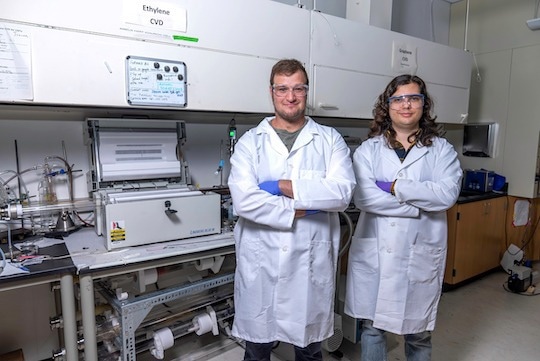The tunable molecular structure, large surface area, and porosity of covalent organic frameworks (COFs), a class of crystalline polymers with potential applications in energy, semiconductor devices, sensors, filtration systems, and drug delivery, have been made possible by a rapid, inexpensive, and scalable method developed by materials scientists at Rice University.
 Alec Ajnsztajn (left) and Jeremy Daum. Image Credit: Gustavo Raskosky/Rice University
Alec Ajnsztajn (left) and Jeremy Daum. Image Credit: Gustavo Raskosky/Rice University
What makes these structures so special is that they are polymers but they arrange themselves in an ordered, repeating structure that makes it a crystal. These structures look a bit like chicken wire ⎯ they are hexagonal lattices that repeat themselves on a two-dimensional plane, and then they stack on top of themselves, and that’s how you get a layered 2D material.
Jeremy Daum, Ph.D. Student. Department of Materials Science and Nanoengineering, Rice University
The other lead author of the study, Alec Ajnsztajn, a Rice doctorate graduate, explained that the synthesis method enables vapor deposition to quickly create ordered 2D crystalline COFs.
A lot of times when you make COFs through solution processing, there is no alignment on the film. This synthesis technique allows us to control the sheet orientation, ensuring that pores are aligned, which is what you want if you are creating a membrane.
Alec Ajnsztajn, Ph.D. Student, Rice University
The capacity to regulate pore size is helpful in separators, where COFs may be able to replace energy-intensive procedures like distillation by acting as membranes for desalination. COFs might be utilized as organic transistors and battery separators in electronics.
Daum added, “COFs have the potential to be useful in a variety of catalytic processes ⎯ you might, for instance, use COFs to break down carbon dioxide into useful chemicals like ethylene and formic acid.”
The longer and more challenging manufacturing procedures, including solution processing, that COFs require in industrial settings are one of the obstacles keeping them from being employed more extensively.
Ajnsztajn stated, “It can take three to five days of reaction time to produce the powders for the solutions needed to generate COFs. Our method is much faster. After months of optimizing, we managed to produce high-quality films in just 20 minutes or less.”
Daum and Ajnsztajn traveled to the Argonne National Laboratory and used the Advanced Photon Source to analyze their samples, working nonstop in shifts for 71 hours to ensure their films showed the correct chemical structure.
“We knew it was ‘go’ time, but we were so happy with the results. We had to go to a national lab because this technique was the only way to measure the quality of our films and ensure we’d taken the right measures to optimize them,” Daum noted.
Studies using microscopy shed light on the growth process of COF crystals and show that organic molecules can be synthesized at temperatures as high as 340 degrees Celsius (~644 degrees Fahrenheit).
“While working on this project, we have heard from many people who thought that heating organic molecules up to such high temperatures would prevent the right reactions from occurring, but what we found is that chemical vapor deposition is a viable way to create organic materials,” Ajnsztajn further added.
Daum and Ajnsztajn constructed an improvised reactor using cheap, easily accessible materials and leftover pieces of lab equipment to create the COFs.
Daum further stated, “This entire process was something that was very cheap to assemble. Establishing a robust, scalable process of producing a variety of COF films will hopefully allow for the better application of COFs in catalysis, energy storage, membranes and more.”
The study’s corresponding authors are Rafael Verduzco, a professor of materials science and nanoengineering and chemical and biomolecular engineering, and Pulickel Ajayan, the Benjamin M. and Mary Greenwood Anderson Professor in Engineering, professor and chair of materials science and nanoengineering, professor of chemistry, and professor of chemical and biomolecular engineering.
The study was funded in part by the National Science Foundation (2247729, 1842494), the U.S. Air Force Office of Scientific Research and Clarkson Aerospace Corporation (FA9550-21-1-0460), the Welch Foundation (C-2124), UES (S-119-005-003, Award number 116000, Project name G10000097), and the U.S. Air Force Research Laboratories.
Journal Reference:
Daum, J., et. al. (2023) Solutions Are the Problem: Ordered Two-Dimensional Covalent Organic Framework Films by Chemical Vapor Deposition. ACS Nano. doi:10.1021/acsnano.3c06142